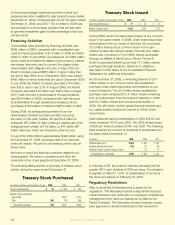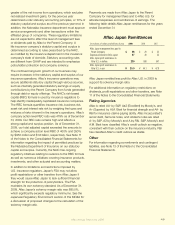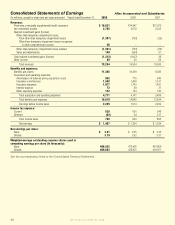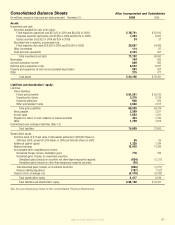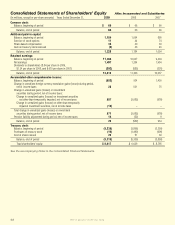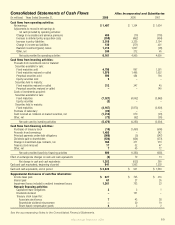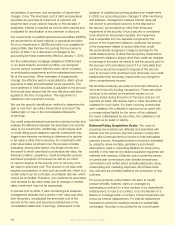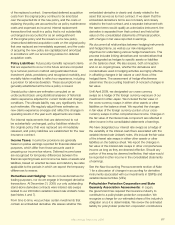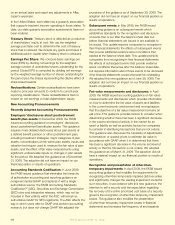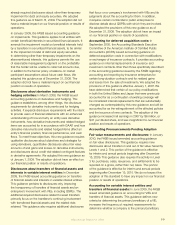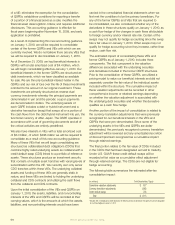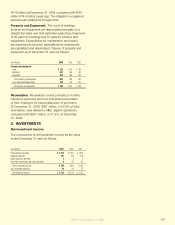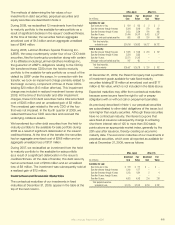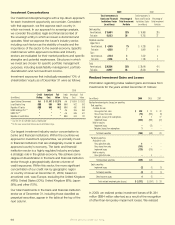Aflac 2009 Annual Report Download - page 62
Download and view the complete annual report
Please find page 62 of the 2009 Aflac annual report below. You can navigate through the pages in the report by either clicking on the pages listed below, or by using the keyword search tool below to find specific information within the annual report.
on an annual basis and report any adjustments in Aac
Japan’s expenses.
In the United States, each state has a guaranty association
that supports insolvent insurers operating in those states. To
date, our state guaranty association assessments have not
been material.
Treasury Stock: Treasury stock is reected as a reduction
of shareholders’ equity at cost. We use the weighted-
average purchase cost to determine the cost of treasury
stock that is reissued. We include any gains and losses in
additional paid-in capital when treasury stock is reissued.
Earnings Per Share: We compute basic earnings per
share (EPS) by dividing net earnings by the weighted-
average number of unrestricted shares outstanding for the
period. Diluted EPS is computed by dividing net earnings
by the weighted-average number of shares outstanding for
the period plus the shares representing the dilutive effect of
share-based awards.
Reclassications: Certain reclassications have been
made to prior-year amounts to conform to current-year
reporting classications. These reclassications had no
impact on net earnings or total shareholders’ equity.
New Accounting Pronouncements
Recently Adopted Accounting Pronouncements
Employers’ disclosures about postretirement
benet plan assets: In December 2008, the FASB
issued accounting guidance on employers’ disclosures
about postretirement benet plan assets. This guidance
requires more detailed disclosures about plan assets of
a dened benet pension or other postretirement plan,
including investment strategies; major categories of plan
assets; concentrations of risk within plan assets; inputs and
valuation techniques used to measure the fair value of plan
assets; and the effect of fair value measurements using
signicant unobservable inputs on changes in plan assets
for the period. We adopted this guidance as of December
31, 2009. The adoption did not have an impact on our
nancial position or results of operations.
Accounting Standards Codication: In June 2009,
the FASB issued guidance that eliminates the hierarchy
of authoritative accounting and reporting guidance on
nongovernmental GAAP and replaces it with a single
authoritative source, the FASB Accounting Standards
CodicationTM (ASC). Securities and Exchange Commission
(SEC) rules and interpretive releases, which may not be
included in their entirety within the ASC, will remain as
authoritative GAAP for SEC registrants. The ASC affects the
way in which users refer to GAAP and perform accounting
research, but does not change GAAP. We adopted the
provisions of this guidance as of September 30, 2009. The
adoption did not have an impact on our nancial position or
results of operations.
Subsequent events: In May 2009, the FASB issued
accounting guidance on subsequent events which
establishes standards for the recognition and disclosure
of events that occur after the balance sheet date but
before nancial statements are issued or are available to
be issued. This update requires companies to recognize in
their nancial statements the effects of subsequent events
that provide additional evidence about conditions that
existed at the balance sheet date. This update prohibits
companies from recognizing in their nancial statements
the effects of subsequent events that provide evidence
about conditions that arose after the balance sheet date,
but requires information about those events to be disclosed
if the nancial statements would otherwise be misleading.
We adopted this new guidance as of June 30, 2009. The
adoption did not have an impact on our nancial position or
results of operations.
Fair value measurements and disclosures: In April
2009, the FASB issued accounting guidance on fair value
measurements and disclosures which provides information
on how to determine the fair value of assets and liabilities
in the current economic environment and re-emphasizes
that the objective of a fair value measurement remains an
exit price. This guidance provides factors to consider when
determining whether there has been a signicant decrease
in the volume and level of activity in the market for an
asset or liability as well as provides factors for companies
to consider in identifying transactions that are not orderly.
This guidance also discusses the necessity of adjustments
to transaction or quoted prices to estimate fair value in
accordance with GAAP when it is determined that there
has been a signicant decrease in the volume and level of
activity or that the transaction is not orderly. We adopted
this guidance as of March 31, 2009. The adoption did not
have a material impact on our nancial position or results of
operations.
Recognition and presentation of other-than-
temporary impairments: In April 2009, the FASB issued
accounting guidance that modies the requirements for
recognizing other-than-temporarily impaired debt securities
and signicantly changes the existing impairment model for
such securities. In accordance with this new guidance, the
intention to sell a security and the expectation regarding
the recovery of the entire amortized cost basis of a security
governs the recognition of other-than-temporary impairment
losses. This guidance also modies the presentation
of other-than-temporary impairment losses in nancial
statements and increases the frequency of and expands
We’ve got you under our wing.
58


